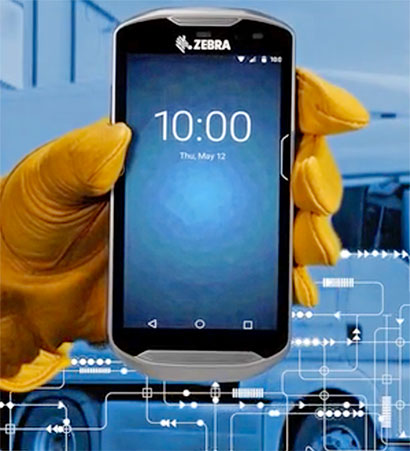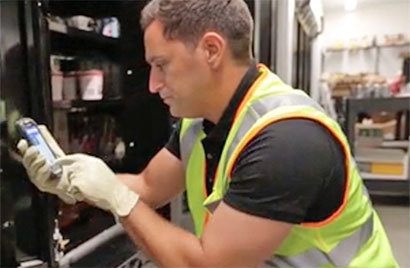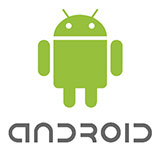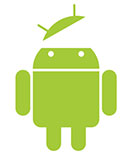|
Zebra TC5 Series Touch Computer
Looks like a modern smartphone, but one with enterprise-class durability, power and security
(by Conrad H. Blickenstorfer)
On November 14, 2016, Zebra Technologies introduced the TC5 Series of "touch mobile computers." These are devices that in the guise of the ubiquitous and immensely popular smartphone form factor seek to bring ruggedness, dependability and superior security to business and enterprise customers. A tough job and a tough nut to crack? Yes, but having sold over a million enterprise-class Android devices already, Zebra seems quite uniquely qualified to getting it right.

So what is this new TC5 Series? It looks like a modern smartphone, with a footprint just a tad smaller than that of the iPhone 7 Plus. With, of course, a capacitive multi-touch screen that measures 5 inches diagonally — placing it between the iPhone 7 and 7 Plus — and offers super-sharp retina-class resolution. And with a speedy 1.8GHz Snapdragon hexa-core (yes, that's six cores) processor and a 13 megapixel camera with a bright f/2.4 lens. We're talking attractive handheld computing and communication hardware here, and that's even before we get into all the extras Zebra baked into this device, the extras that make it a tool for the job and not just a tougher smartphone.

Android masters
As far as Zebra's Android expertise goes, that of course comes from the fortuitous acquisition of Motorola Solutions' enterprise division which, though largely consisting of the former Symbol Technologies that Motorola had acquired in 2007, greatly benefitted from Motorola's Android DNA that goes back to the original Droid phone released late 2009.
 Android took a while to percolate until it began its ascent to the dominant position it enjoys in consumer phones today. The percolation took longer in enterprise and industrial markets that kept (futilely) hoping Microsoft would not leave them stranded with the dead-end Windows Mobile. However, that all changed on October 1, 2013, when Motorola Solutions announced that three of its popular enterprise mobile computers would be available with Android (see our "October 1, 2013 -- the day Moto Solutions and Honeywell/Intermec became serious about Android").
Android took a while to percolate until it began its ascent to the dominant position it enjoys in consumer phones today. The percolation took longer in enterprise and industrial markets that kept (futilely) hoping Microsoft would not leave them stranded with the dead-end Windows Mobile. However, that all changed on October 1, 2013, when Motorola Solutions announced that three of its popular enterprise mobile computers would be available with Android (see our "October 1, 2013 -- the day Moto Solutions and Honeywell/Intermec became serious about Android").
At the time we said that "it's fairly safe to assume that these are just first steps. The proposed hardware still represents compromises and is not (yet) truly Android optimized." That quickly changed. With each successive product, Zebra improved and refined the use of Android in enterprise handheld computers, resulting in its current leadership position.
Getting Android ready for the enterprise
Android started as Google's attempt to compete with the iPhone whose revolutionary use of capacitive multi-touch had changed the industry.  Early versions of Android were clumsy, but lacking any other options to break into the burgeoning smartphone market, the platform grew and improved in leaps and bounds. Android was, however, mostly geared towards consumers and lacked the security and management features essential for enterprise use. Zebra addressed that by creating a layer of Android Mx extensions that added enterprise-class security, manageability, data capture and wireless connectivity (see Zebra's Fortified Android for the Enterprise document). Early versions of Android were clumsy, but lacking any other options to break into the burgeoning smartphone market, the platform grew and improved in leaps and bounds. Android was, however, mostly geared towards consumers and lacked the security and management features essential for enterprise use. Zebra addressed that by creating a layer of Android Mx extensions that added enterprise-class security, manageability, data capture and wireless connectivity (see Zebra's Fortified Android for the Enterprise document).
Extensions, however, can't address another Android issue. It's a consumer platform with easy, unlimited access to entertainment and apps.  That is not necessarily a good thing in business where devices are used for work and the last thing they should do is invite and facilitate distraction. And that is why Zebra is using ASOP. That stands for Android Open Source Project and was conceived to be an open platform available for anyone to implement their own ideas. It is led by Google itself, but comes without the Google Play store and many of the entertainment-oriented Google apps. In a way, the Android Open Source Platform is to Android what Windows CE is to Windows Mobile, i.e. AOSP is the open source underlying engine without the proprietary apps (which Google calls Google Mobile Services, or GMS) on top of it. That is not necessarily a good thing in business where devices are used for work and the last thing they should do is invite and facilitate distraction. And that is why Zebra is using ASOP. That stands for Android Open Source Project and was conceived to be an open platform available for anyone to implement their own ideas. It is led by Google itself, but comes without the Google Play store and many of the entertainment-oriented Google apps. In a way, the Android Open Source Platform is to Android what Windows CE is to Windows Mobile, i.e. AOSP is the open source underlying engine without the proprietary apps (which Google calls Google Mobile Services, or GMS) on top of it.
 But that is still not all. There is also Android for Work, which was designed by Google to provide enterprise features for Android users. These include application management, device security, and data and security separation of work and personal data including email. Android for Work essentially provides a device with a "work" personality and a standard "user" personality. Anything on the "work" side is clearly marked with a little icon. The enterprise aspects of Android for Work are illustrated in this graphic. But that is still not all. There is also Android for Work, which was designed by Google to provide enterprise features for Android users. These include application management, device security, and data and security separation of work and personal data including email. Android for Work essentially provides a device with a "work" personality and a standard "user" personality. Anything on the "work" side is clearly marked with a little icon. The enterprise aspects of Android for Work are illustrated in this graphic.
All Zebra TC5 Series devices use the AOSP open source version of Android 6.0 "Marshmallow." But since not every customer's requirements are the same, Zebra offers configurations with or without Android for Work and the Google Mobile Services. It can get a bit confusing, so prospective customers must make sure to clearly understand the differences and implications of all those options.
The hardware
To recap and flesh out the hardware aspects of the Zebra TC5 Series, the device has roughly the same footprint as an iPhone 7 Plus (6.1 x 2.9 inches), but ruggedness, components and replaceable battery make it thicker (0.73 inches) and heavier (8.8 ounces) than a consumer phone. There's the speedy 1.8GHz 6-core processor. Storage comes in two versions: 2GB RAM and 16 GB Flash, or 4GB RAM and 32GB Flash. In both cases, that's augmentable via MicroSD slot up to 64GB of SDXC card storage.
WiFi is of the dual-band, speedy 802.11a/b/g/n/ac variety that also includes 802.11d/h/i/r, those handling global roaming, interference elimination, enhanced security and fast roaming, respectively. There's also Class 2 Bluetooth v4.1, NFC and GPS (the documentation isn't totally clear on the GPS type). There's 4G LTE as well as older version support of mobile broadband in both global and Americas versions, and there's integrated 1D/2D scanning via a Zebra SE4710 imager (see SE4710 spec sheet). Wired communication is via USB-C.
The rechargeable Li-Ion battery is described as packing 4,300 mAh. but no data on voltage or estimated battery life per charge.
Since many prospective TC5 Series users will use their devices for voice communication in noisy areas, there's not only standard phone functionality, but also push-to-talk, a speaker that's four times as loud as your average consumer phone speaker, and there's noise cancellation.
Built to last
While the enterprise deployments Zebra has in mind with the new TC5 Series aren't generally environmentally harsh working environments, the company made sure TC5x devices are easily capable of handling most adverse situations they may encounter. It can survive four-foot drops to tile over concrete (5-foot with optional rugged boot) and was subjected to 500 half-meter tumbles in tests. The 14 to 122 degree Fahrenheit operating temperature range is wide enough for virtually all intended applications. There is also vibration resistance testing data, but sealing isn't addressed in the specs. Zebra's promo video for the TC5 Series, does show a faucet running water over the device, but we'd like to know the actual ingress protection rating.
Zebra TC5 Series: Enterprise Android devices evolved
While not officially designated the successor of the Zebra TC55 that has been around for going on three years, the new TC5 Series devices sure do look the part. Similar design as the old TC55, but with a larger and sharper display, a faster processor, more memory, faster communication, a slew of other tech upgrades and, of course, the newer, better and more secure version of Android, customizable and optimized for business. The new Zebra TC5 Series makes a whole lot of sense. --Conrad H. Blickenstorfer, November 2016
|



